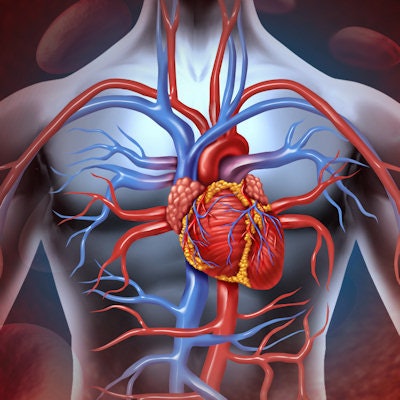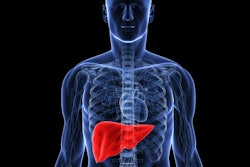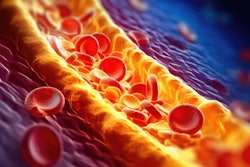
Coronary CT angiography (CCTA) measurements of coronary artery plaque volumes are reproducible at follow-up when the same scanner is used, but reproducibility declines below acceptable levels when follow-up is performed on a different scanner model, concludes a study published recently in Radiology.
Researchers from the U.S. National Institutes of Health evaluated the performance of two state-of-the-art CT scanners in 40 patients. The patients underwent CCTA on one scanner (Aquilion One Vision, Toshiba Medical Systems) and then had follow-up CCTA within 30 days on either the same scanner or a model from another vendor (Somatom Force, Siemens Healthineers) using software for plaque analysis.
"The results showed that readers were extremely reliable using software, and their ability to find the plaque and measure it was highly reproducible," said corresponding author Dr. David Bluemke, PhD, in an interview with AuntMinnie.com.
The results varied less than 19% for the same-model scenario; however, they varied up to 30% when follow-up was performed on a different scanner.
"There are differences among CT scanners in how they detect plaque that really cause the changes we see in plaque measurement," he said.
Measuring plaque volume
Coronary artery disease characterized by progressive increases in coronary plaque volume over time can lead to plaque rupture and coronary artery thrombosis, but measuring these changes is difficult. Ultrasound studies of patients undergoing statin therapy have shown mixed results with regard to the ability of medications to reduce plaque volumes, the authors wrote (Radiology, December 2016, Vol. 281:3). The development of high-dose, high-potency statin therapy and other therapies aimed at plaque reduction offers the potential to reduce plaque volumes.
Intravascular ultrasound (IVUS) is the gold standard for assessing plaque volumes, but the invasive and time-consuming exam makes it impractical for routine follow-up. The goal of the current study was to determine how well less-invasive CCTA could fill that role.
Previous studies with CCTA have shown fairly good reproducibility for measuring stenosis and plaque volumes, but little is known about the variability of the CCTA scans themselves. Also, the use of semiautomated plaque quantification software may improve CCTA reproducibility and reduce intervendor variability in plaque assessment beyond that of previous studies.
"We hypothesized that state-of-the-art coronary CT angiography hardware and software can reliably measure coronary plaque volume" as part of a larger effort to determine whether CCTA can reliably assess plaque volume changes as the potential result of statin therapy, they wrote.
In all, 40 patients (mean age, 67 years) with stable coronary artery disease underwent baseline Agatston coronary artery calcium scoring and coronary CT angiography on the Toshiba scanner. They were randomized to follow-up CCTA on either the Toshiba or the Siemens scanner within 19 days ± 6 of the original scan. Oral beta-blockers were administered if the patient's resting heart rate was greater than 65 beats per minute.
Two trained readers (one and five years of experience, respectively) performed plaque analysis on a dedicated workstation using validated software (QAngioCT, version 2.1.9.1, Medis Medical Imaging Systems). They assessed interreader, intrareader, and interstudy reproducibility using intraclass correlation coefficients (ICCs) and Bland-Altman analysis.
Less variability with same vendor
The results showed scanner variability (coefficient of variation) of ± 18.4% when follow-up occurred on the same (Toshiba) scanner. But variability rose to ± 29.9% when the follow-up scan came from a different vendor (Toshiba). The sample size required to detect a 5% change in noncalcified plaque volume with 90% power and an α error of 0.05 was 286 subjects for same-vendor follow-up and 753 subjects with different-vendor follow-up, according to the authors.
The scan-rescan variation showed no significant bias but was significantly better for the same-vendor group 1 than the different-vendor group 2 for total plaque, with a vessel ICC of 0.967 for group 1 versus 0.766 for group 2, and a lesion ICC of 0.964 for group 1 versus 0.788 for group 2. Similar results were seen in noncalcified plaque.
| CCTA plaque measurement variability by scanner | ||||
| Toshiba both scans | Toshiba then Siemens | |||
| ICC | Difference | ICC | Difference | |
| Vessel-based analysis | ||||
| Total plaque | 0.967 | 1.3% | 0.766 | 4.7% |
| Calcified plaque | 0.968 | 5.3% | 0.936 | 14.4% |
| Noncalcified plaque | 0.948 | 0.2% | 0.609 | 2.3% |
| Lesion-based analysis | ||||
| Total plaque | 0.964 | 1.0% | 0.788 | 2.1% |
| Calcified plaque | 0.964 | 4.2% | 0.924 | 8.2% |
| Noncalcified plaque | 0.950 | 0.1% | 0.642 | 2.4% |
The mean radiation dose was 4.5 mSv for the Toshiba scanner and 4.8 mSv for the Siemens scanner.
A role for monitoring
The results indicate that state-of-the-art coronary CT angiography with same-vendor follow-up has good scan-rescan reproducibility, suggesting a role for CCTA in monitoring coronary artery plaque response to therapy, the authors wrote. Differences between coronary CT angiography vendors resulted in lower scan-rescan reproducibility.
"If people are going to be looking at the amount of disease they have in their hearts and how that changes over time, it's really essential to have at least the same manufacturer and the same platform for the CT scan on the follow-up assessment," Bluemke said.
How is it that two different CT scanners, and to a lesser extent the same scanner on the same patient at different times, came up with divergent results?
"Once we establish that the readers and the software are reliable, we can look at other factors, [i.e.,] a combination of patient variability such as changes in heart rate between scans and slight differences in the detection of ECG by CT scanners," Bluemke said. "In addition, there are differences in how they detect the plaque that really cause the changes in answers that we see in plaque measurement. It is attenuation differences and also the differences in detection of different types of materials in the arteries, and the very sophisticated rules of processing that scanners have to use to detect these small structures in the coronary arteries -- so it's a jumble of things they use to come up with a picture."
The results mean that state-of-the-art CCTA can be used to characterize both the extent and composition of total coronary plaque burden and for plaque volume analysis of focal coronary lesions, the authors wrote. What they don't mean, Bluemke added, is that one scanner is doing the job better than the other.
Previous studies have shown good reproducibility for calcified plaque but less accurate results for noncalcified plaque. The improved accuracy in this study on both counts can probably be attributed to the evolution of CT scanning, as well as the value of software used to assess plaque volume, according to the authors.
Study limitations include its single-center design and relatively small sample. Also, the researchers did not include further subclassification of noncalcified plaque into fatty and fibrous components, or perform the initial scan on both scanners. Only two state-of-the-art scanners were compared.
Going forward, the group will "continue to assess reproducibility on each new state-of-the-art scanner when it comes out," Bluemke said. "We expect that newer scanners are going to do even better. Second, we're conducting studies to reverse plaque in the coronary arteries with high-intensity statin therapy."
The goal at this point is to determine if statins really work, "and more importantly to determine if they can reduce the atherosclerosis in our arteries," he said. "Based on invasive IVUS, the statin doesn't seem to reverse the plaque in up to 40% of the individuals -- in other words, it gets worse. CT technology now has the potential to see if your medication is working, and we'd like to further prove whether the right dose of statin is being given to the right patient."




















